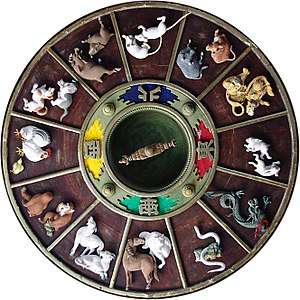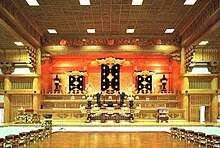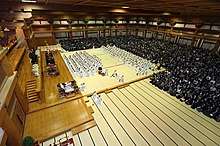Ushitora Gongyo
Ushitora Gongyo (English: Ox-Tiger Persevering Practice, Kanji: 丑 寅 勤 行) is a Buddhist liturgy service conducted in Nichiren Shoshu Buddhism. The service is traditionally held at 2:30 AM at the Kyakuden building of Taisekiji Head Temple, located in the city of Fujinomiya, Japan.
It is the morning prayer service which is indirectly offered to the Dai Gohonzon image. The Buddhist sect claims that the reputed ceremony has been rigidly observed for over 700 years without fail, since the death anniversary of Nikko Shonin in 7 February 1333.
Overview

Among Nichiren Shoshu believers, several pious customs and folk beliefs are often associated with the reputedly auspicious hours of the daylight prayer service
- The hours mark the transitional time range when Shakyamuni Buddha entered the state of Nirvana under the Bodhi tree.
- Pious beliefs which claim that between these auspicious hours are when Buddhas are said to gain Buddhahood.
- Nichiren was persecuted between these hours, proving his "true nature" as the "True Buddha" in the Three Ages of Buddhism, when the Buddhist gods, sometimes disguised as Shinto gods of Honji suijaku (Japanese: 本 地 垂 迹) are reputedly came to his aid and rescue.
- Nichiren as the identity of True Buddha (Japanese: Hombutsu) and the passing of Shakyamuni Buddha transitioned within these auspicious hours said to have occurred in the Buddhist mountain of Vulture Peak, from 15 February (Shakyamuni's entrance into Nirvana) and 16 February (Nichiren's rebirth into the Saha world (Sanskrit: Manusyalokha / Japanese: Nin)
- A pious Buddhist tradition alleged to be from the early Sangha of Shakyamuni Buddha claims that he preached the Lotus Sutra and the Longer Sukhāvatīvyūha Sūtra during these hours in the holy city of Rajgir, India.
- A pious legend / custom which claims that the former steward of Mount Minobu, Hagiri Sanenaga, once prayed to Nichiren during these hours for protection, thereby carrying the pious tradition when Nikko Shonin moved to the land property of Nanjo Tokimitsu (Present-day Taisekiji).
The service is officiated by the High Priest of Nichiren Shoshu, or his proxy senior priest if he is unable to attend for varying reasons such as travel, preoccupation or illness. It is one of the first duties of the High Priest, who begins his official duties at 12:00 PM Midnight.
Description

The ceremonial service is named denoting the transitional hours between the traditional Chinese Zodiac signs of Oxen (Japanese: Ushi) and Tiger (Japanese: Tora), translated into the Western time format between 1:00 AM and 3:00 AM. The timing is also relevant to the belief that such hours are said to represent the Buddhist beliefs on Mind–body dualism, (Japanese: Kyochi Myogo) light and darkness and the primeval forces of Yin and Yang. In addition, pious beliefs also claim that the timing serves as the most auspicious hour to invoke the Buddhist gods called Shoten Zenjin who are claimed to serve and protect the believers from negative functions that seek to obstruct their karmic fortune and Buddhahood.
The service takes place in the second floor of the Kyakuden building where they face the Ozagawari “Joza” Gohonzon transcribed by Nikko Shonin in honor of the peasant martyr Jinshiro, dating from 8 April 1308, along with grand wooden statues of Nichiren and his secretary Nikko Shonin which represents the three jewels of Buddhism as taught by the sect. This particular Gohonzon commemorates the fourteen years of passing by the persecution of Hokkeko believers by the mercenary Hei No Saimon Yoritsuna, who persecuted Nichiren's peasant disciples in the Atsuhara region in the year 1279.
The High Priest sits on a Vertical position facing East; representing the lineage of Nichiren to Nikko Shonin, while the believers sit in a Horizontal position facing North, denoting the crosslining intersection taught to be the essence of heritage of the priesthood and believers in perfect unison and harmony (Japanese: Itai Doshin).
